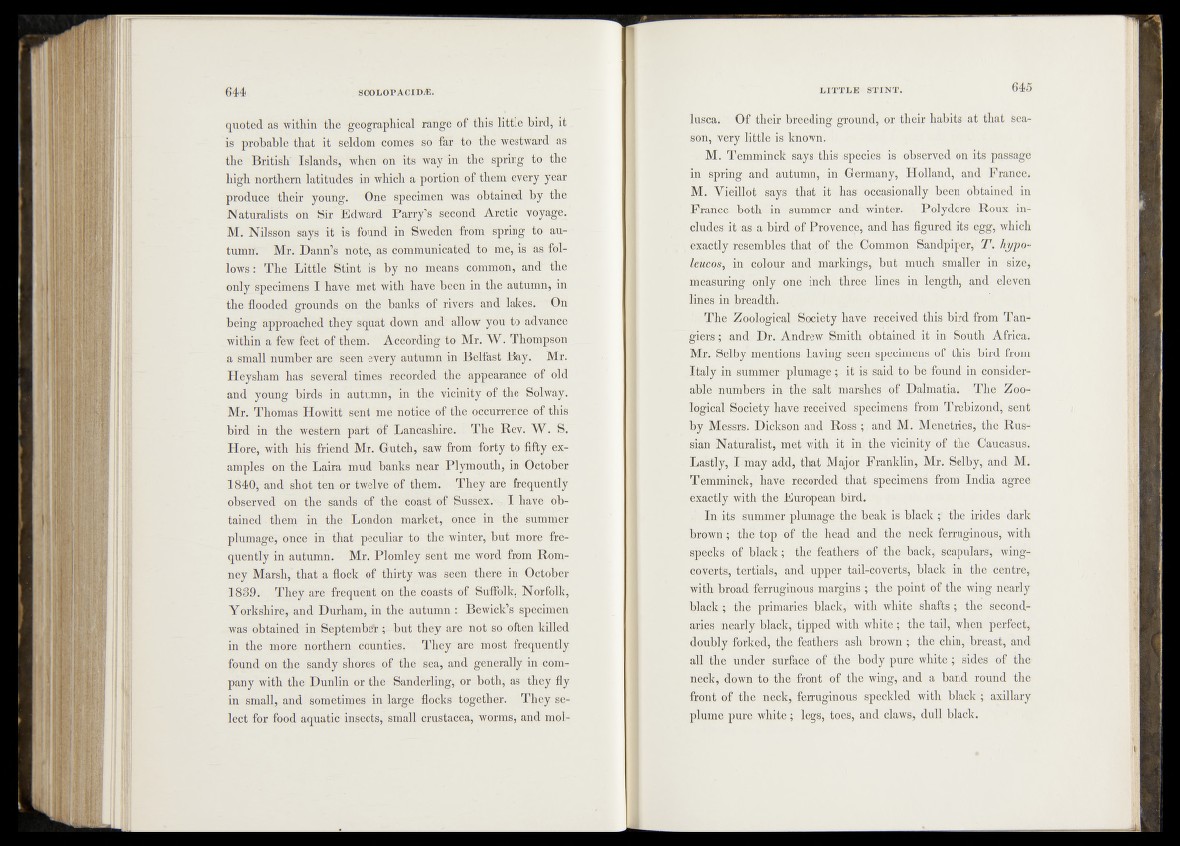
quoted as within the geographical range of this little bird, it
is probable that it seldom comes so far to the westward as
the British' Islands, when on its way in the spring to the
high northern latitudes in which a portion of them every year
produce their young. One specimen was obtained by the
Naturalists on Sir Edward Parry’s second Arctic voyage.
M. Nilsson says it is found in Sweden from spring to autumn.
Mr. Dann’s note, as communicated to me, is as follows
: The Little Stint is by no means common, and the
only specimens I have met Vrith have been in the autumn, in
the flooded grounds on the banks of rivers and lakes. On
being approached they squat down and allow you to advance
within a few feet of them. According to Mr. W . Thompson
a small number are seen every autumn in Belfast Bay. Mr.
Heysham has several times recorded the appearance of old
and young birds in autumn, in the vicinity of the Solway.
Mr. Thomas Howitt sent me notice of the occurrence of this
bird in the western part of Lancashire. The Rev. W . S.
Hore, with his friend Mr. Gutch, saw from forty to fifty examples
on the Laira mud banks near Plymouth, in October
1840, and shot ten or twelve of them. They are frequently
observed on the sands of the coast of Sussex.':. I have obtained
them in the London market, once in the summer
plumage, once in that peculiar to the winter, but more frequently
in autumn. Mr. Plomley sent me word from Romney
Marsh, that a flock of thirty was seen there in October
1839. They are frequent on the coasts of Suffolk, Norfolk,
Yorkshire, and Durham, in the autumn : Bewick’s specimen
was obtained in September ^ but they are not so often killed
in the more northern counties. They are most frequently
found on the sandy shores of the sea, and generally in company
with the Dunlin or the Sanderling, or both, as they fly
in small, and sometimes in large flocks together. They select
for food aquatic insects, small Crustacea, worms, and mollusca.
Of their breeding ground, or their habits at that Sea-
son, very little is known.
M. Temminck says thissspecies is observed on its passage
in spring and autumn, in Germany, Holland, and France#
M. Vieillot says that it has occasionally been obtained in
France* both in summer and winter. Polydore Roux includes
it - as a bird of Provence, and has figured its egg, which
exactly resembles that of the Common Sandpiper, T . hypo-
leucos, in colour and markings, but much smaller in size,
measuring only one inch three lines in length, and eleven
lines in breadth#
The Zoological Society have received this bird from Tan-
giers; and, Dr. Andrew Smith obtained it in South Africa#
Mr. Selby mentions having seen specimens of this, bird from
Italy in summer plumage;, it is said-to be found in considerable
numbers in the salt marshes, of Dalmatia# - The Zoological
Society have received specimens from Trebizond, Sent
by Messrs. Dickson and Ross and M. Menetries, the Russian
Naturalist, met with it in the vicinity of the Caucasus.
Lastly, I may add, that Major Franklin, Mr. Selby, and M.
Temminck, have recorded that specimens from India agree
exactly with the European bird.
. In its summer plumage the beak is black ? the irides dark
brown ; the top of the head and the neck ferruginous, with
specks of black; the feathers Of the back," scapulars, wing-
coverts, tertials, and upper tail-coverts, black in the centre,
with broad ferruginous margins ; the point of the wing nearly
black; the primaries black, with white shafts; the secondaries
nearly black, tipped with white; the tail, when perfect,
doubly forked, the feathers ash brown ; the chin, breast, and
all the under surface of the body pure white; sides of the
neck, down to the front of the wing, and a band round the
front of the neck, ferruginous speckled with black; axillary
plume pure white; legs, toes, and claws, dull black.